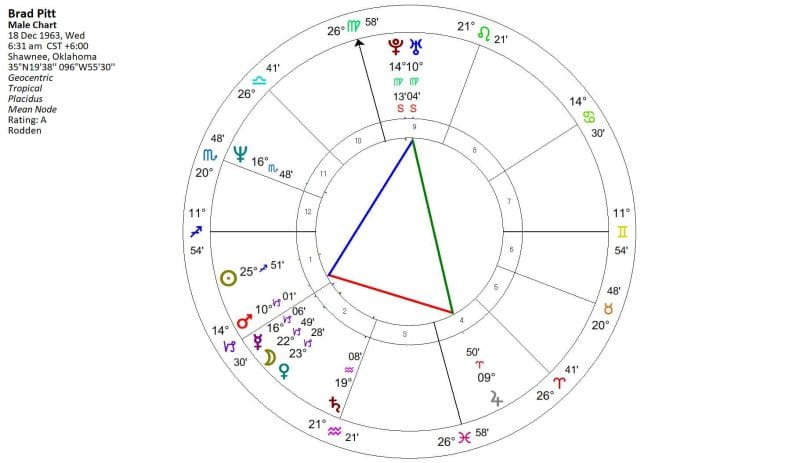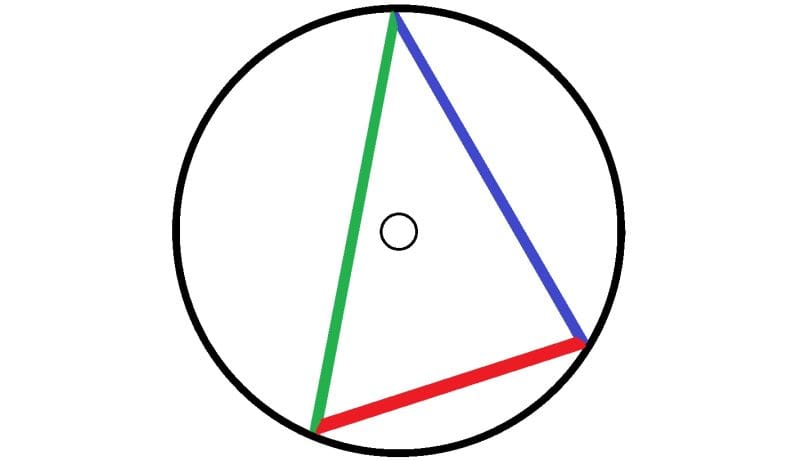A Dominant Triangle aspect pattern is a type of learning triangle that includes a red square, blue trine, and green quincunx aspect. Three-colored aspect patterns are learning or development figures, in which the third color (green) plays an important role.
Green aspects bring a third point of view into the equation, which, for better or worse, supersedes the polarized thinking of the red and blue aspects with a third pole; green aspects allow an escape from black-or-white thinking and a search for causes, possible solutions and meaning.
With a quincunx, information is classified and integrated with the greater whole until the connections are understood. As a “large thinking step”, it develops a micro-macrocosmic way of thinking based on the hermetic principle “as above, so below”. You question the meaning of existence, search for causes and motivations, and gain a better understanding of different kinds of human behavior. This mind-expanding aspect encourages psychological thinking, the understanding of connections and allows the discovery of the meaning and purpose of things.
Crisis Mechanism
In the Dominant Triangle, there is a procedure that conditions growth by an ongoing crisis mechanism that opens up great opportunities for development. There are three phases to the crisis mechanism: red-green-blue.
The dynamic process starts with the red aspect (square). The point of conflict is where the red and blue elements touch each other. The calm, balanced, pleasure-seeking state of the blue aspect (trine) is disturbed or irritated, causing tension or conflict, and some decision or effort must be made. The old state is no longer tenable; a problem has arisen that must be solved.
red → green → blue
square → quincunx → trine
conflict → striving for solution → harmonization
The red square aspect shows a regular and drastic experience of conflict due to feelings of inadequacy because of a particular problem.
The green quincunx aspect is the next step where the problem is initially dealt with. Searching for a solution can lead to a change in self-image.
The blue trine aspect is the desired state of harmony that comes from creative problem-solving. Ego transformation results in a more dominant and influential personality.
Learning and Development
The crisis mechanism in the Dominant Triangle is a development spiral that aims to get another point of view with every complete transition. Every passage through the three phases and each one of the crises contains the possibility of finding solutions that previously did not exist, i.e., breaking new ground. Whether that is successful or not depends on your attitude toward the crisis process. If you inwardly recognize the opportunities, then development is likely. The development process will be blocked if you treat the crises as mere disruptions.
Communication and the provision of information usually lead to new experiences (green aspect). You are always ready to experiment, and the newly acquired discoveries lead you to try to establish a new, harmonious state in a still unsure and unstable position (green-blue contact point in the aspect figure), which meets the requirement of the initial problem. So this process would seem to be complete. But only until a new problem comes along and the crisis mechanism gets going again:
conflict → striving for solution → harmonization
Creativity
There is a pronounced creative quality to the Dominance triangle; thus, in the case of successful problem-solving, producing a personality with a stronger influence and dominance in the environment, But there is a long journey to get that far, as to resolve problems successfully, you have to delve deep into the source of your ego. This means that resolution, liberation and objectives can only be obtained from the core of your personality.
The fundamental problems for the Dominance Triangle are the form and content of self-expression and the formation of the personality. Your ego aligns itself with the trine, which processes experiences, cognition and perspective. The theme of the square usually contradicts this and indicates the directions in which a transformation should take place and where efforts should be made.

The cognitive abilities are often tested, and a qualitative change in the active, achievement-oriented self-expression is called for. Changes of motive and transformations are the order of the day for long periods. A regular and drastic experience of conflict (square) is due to the experience of personal inadequacy vis a vis a specific problem with which you decide to deal with. Now begins the process of the great search (quincunx), which often entails a revision of your self-image.
Rotational Direction
The rotation direction is an important feature in evaluating the Dominant Triangle. [1]It is given by the color order red to green to blue:
Clockwise, in the opposite direction to the zodiac. This is a Retrograde Experience Triangle. It means that many experiences are required to achieve the necessary learning and development. It makes adapting to a more deep-seated problem harder and longer than if the direction were anticlockwise.
Anticlockwise, in the same direction as the zodiac. This is a Cognition Triangle. It means discoveries can be made rapidly because it provides the necessary insights when crises appear. The task to be learned is understood, and intelligence is used to find a solution. With time, you learn how to control and accelerate the process. An enthusiastic, positive attitude towards the theme makes it easier to resolve.
